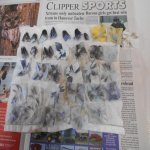Bypass all the theories: Use a borescope.
Save your money - bore scopes don't remove anything, you will still require cleaning agents and a procedure. It is not particularly difficult to clean a bore.
Bypass all the theories: Use a borescope.
Looks like that is a .22, and I'm guessing he only shoots lead.
I have used both Isso and JB bore cleaner. Both work good. If you are looking for something else that is somewhat like them this works great
https://www.flitz.com/gun-bore-cleaner/
Umm that "BLUE" you're complaining about is the copper fouling, dissolving and mixing with the Wipe OUT. When you get through that layer, you will likely run into layer of CARBON, which will be close to black then, if the next patch isn't a GRAY color, it will mean another coat of Wipe Out and you will get BLUE patches again. I see you're using the ''foaming'' Wipe Out Bore Cleaner. I prefer the LIQUID type, which is the same price but will clean three times as many rifles.

Lots of .22 shoot lead with a copper wash - some of which rubs off on the way down the bore.
Lots of them do, yes. Is that what the poster was shooter?
If you mean me, no, it is a factory Husqvarna 6.5x55.
If you meant the OP, then sorry for the waste of band-width.
Save your money - bore scopes don't remove anything, you will still require cleaning agents and a procedure. It is not particularly difficult to clean a bore.
I have a lot of very caked on carbon in a barrel. I have used jb bore paste and bore bright and they remove some but it still exists. I am tired of running literally 100s of patches.
I think the step I am missing is the suggested use of kroil. I can't find kroil anywhere except xreload and don't really want to pay a bunch of shipping on it. Can anyone suggest an alternative penetrating oil that is as powerful as kroil?
I have a lot of very caked on carbon in a barrel. I have used jb bore paste and bore bright and they remove some but it still exists. I am tired of running literally 100s of patches.
I think the step I am missing is the suggested use of kroil. I can't find kroil anywhere except xreload and don't really want to pay a bunch of shipping on it. Can anyone suggest an alternative penetrating oil that is as powerful as kroil?

Just use Wipe Out and you'll likely never bother with bore pastes again.
Some folks do like to suffer though.
He's not trying to "lap" the bore, just clean out the jacket fouling is my assumption
The thorroclean product seems to work better than anything I have tried. Wipeout is good too but the thorroclean is no question a step up if you shoot alot.
Jacket Fouling/Copper is easily removed w/ ammonia.
Sweets 7.62 or Windex will suffice.
JB's is a abrasive/polishing compound
JB's Bore Bright is a rouge base polishing compound.
Lapping compound w/ jag & patch saves time & effort.
Just use Wipe Out and you'll likely never bother with bore pastes again.
Some folks do like to suffer though.
He's not trying to "lap" the bore, just clean out the jacket fouling is my assumption
The thorroclean product seems to work better than anything I have tried. Wipeout is good too but the thorroclean is no question a step up if you shoot alot.
Inexpensive household ammonia will dissolve and bond with copper. It will also clean out any other fouling.
It will take the copper fouling out of cracks, crevices, frosting, and scratches in the bore so those of you with a bore scope can be horrified at the condition of your bore.
Ammonia can't be left in your bore for more than a half hour, without causing pitting. Ammonia will strip the finish of any wooden or composite stock and the fumes are not conducive to good health.
It will also burn your hands or the feet of pets if a drop manages to get on them.
The method you used for cleaning your No4 is over a century old and I will admit, it works very well, IF the person using it knows how to utilize it properly.
I've used it myself on several firearms and will likely be using it on a recently acquired rifle, after Christmas.
The thing to bring to light is there is a very good reason that method of cleaning firearms is only for EXTREME cases. Even back in the day, it was only used in extreme cases.
The washing with hot water was not only to dilute and wash out the ammonia, it was also to dissolve and wash out the corrosive byproducts of the propellants used up to the mid fifties.
WIPE OUT is a much BETTER ALTERNATIVE with few if any hazards to worry about and does the job every bit as well with modern cartridge issues.
The average shooter can easily master Wipe Out. Most shooters have no idea how to clean corrosive residues packed in with jacket fouling.
I've spoken to people, who have never cleaned the bores of their firearms and fully believe the that horrendous pressures endured after shooting ten to twent y boxes of ammo are enough to "wear out a bore"
I have an old barrel, from a pre 64 Mod 70 that would prove you wrong.
Ammonia is corrosive.
Global web icon
ASM Digital Library
https://dl.asminternational.org/.../26/chapter/351287/Corrosion-by-Ammo…
Corrosion by Ammonia | Corrosion: Environments and …
WebThis article discusses the corrosion resistance of materials used for the manufacture, handling, and storage of ammonia. These materials include aluminum alloys, iron and …








































